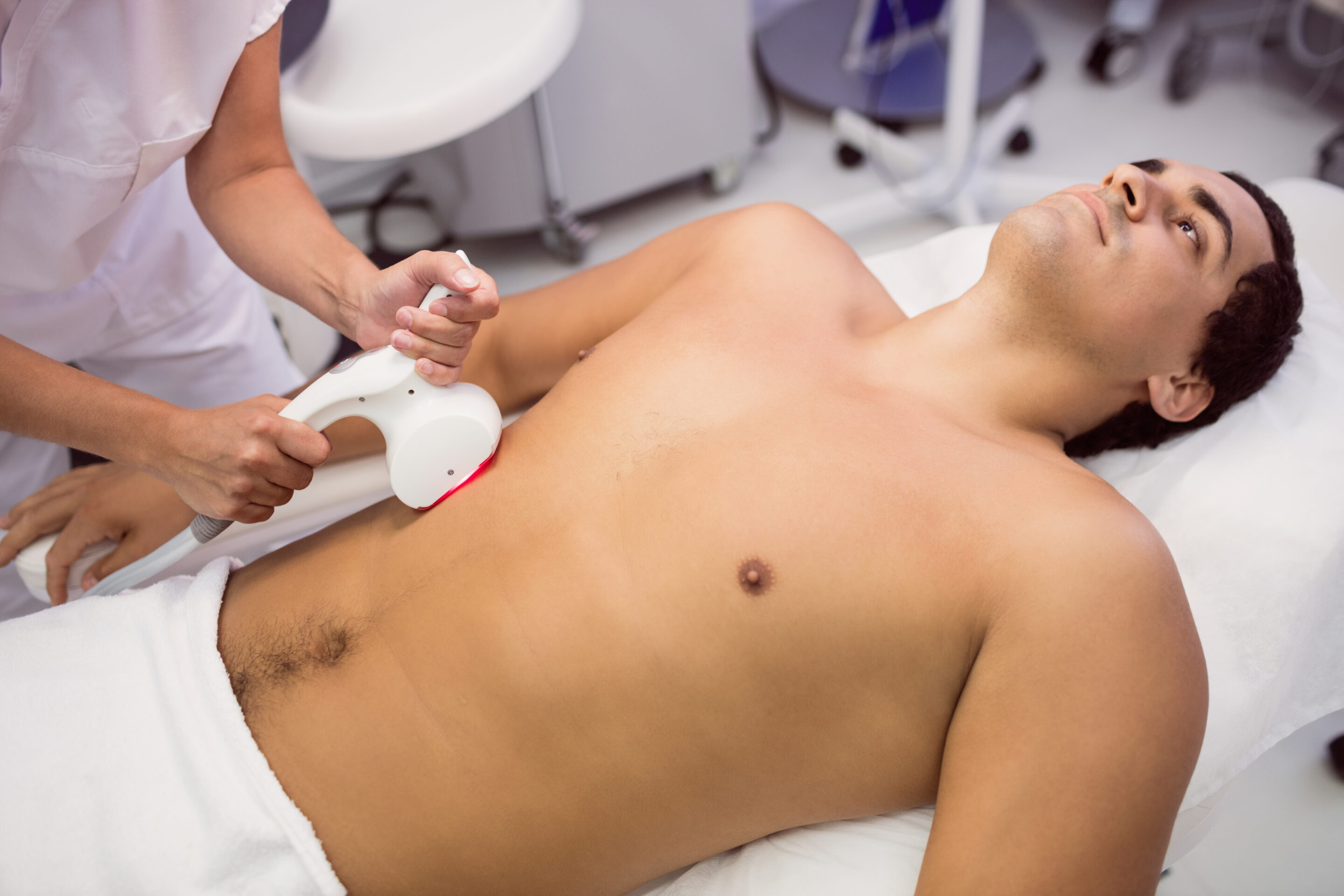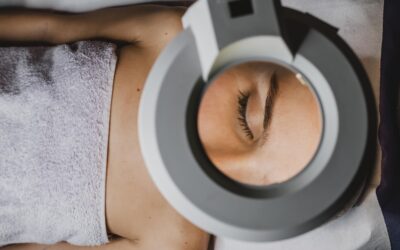Gone are the days when laser hair removal was considered just a women’s treatment. Laser hair removal for men is becoming increasingly popular, as more men discover the benefits of this technology—trading in their razors, Nair, and waxing appointments for a more permanent solution to unwanted hair.
Laser hair removal for men: Why do you need it?
Men deal with unique hair removal challenges. Whether it’s the constant battle with ingrown hairs from shaving, the pain of waxing, or simply wanting less body hair for aesthetic, athletic, or comfort reasons, laser hair removal offers a solution that saves time and hassle in the long run.
Unlike temporary methods like shaving and waxing that need to be repeated weekly or monthly, laser treatments can provide permanent results after just a few sessions. For men with busy schedules, this means less time spent on grooming and more confidence in your appearance.
Laser Hair Removal Treatment Areas for Men
Men typically target different areas than women when it comes to laser hair removal. Here are the most common areas men choose to treat:
laser hair removal back hair and shoulders Back
The back and shoulders is the most popular area for men wanting laser treatments. Back hair can be difficult to reach on your own, making it a constant hassle that often requires help from a partner or professional waxing appointments. Many men feel self-conscious about back hair, especially during summer months or at the gym.
Laser Hair Removal Chest and Abdomen
Chest hair patterns can be uneven, with some men experiencing patches of dense hair while other areas remain relatively sparse. Laser hair removal can help create a more balanced appearance or remove chest hair entirely, depending on your preference. Many men choose to thin out their chest hair rather than remove it completely, which is something a skilled technician can help you achieve. Many men believe laser hair removal is an all or nothing approach to body hair, but this is not true.
Laser Hair Removal for Men’s Facial Hair
Constant shaving can lead to razor burn, ingrown hairs, and irritation, especially along the neck. Many men target this area not to eliminate their beards completely, but to clean up the neckline or define the beard’s edges. Some men also choose to reduce hair density in areas where it grows too thick or treat specific patches to create a more uniform beard appearance.
Ingrown hairs are particularly common on the neck, and laser treatment can provide welcome relief from this painful and unsightly issue, often within the first few sessions.
Laser Hair Removal Ears and Nose
As men age, hair often appears in unwanted places like the ears and nose. These small areas can be effectively treated with laser, though they require precision and specialized techniques to ensure safety around these sensitive features.
What Makes Men’s Laser Hair Removal Different
There are several factors that make laser hair removal for men unique compared to women’s treatments:
Thicker, Denser Hair
Men typically have thicker, coarser hair with deeper roots than women, especially in areas like the back, chest, and face. This actually works in your favor, as laser technology targets the pigment in hair follicles—the darker and coarser the hair, the better the laser can find and destroy it with lower settings. However, this may also mean you need additional sessions to fully treat an area, especially if there are multiple hairs in each follicle.
Testosterone and Hormones
Testosterone plays a significant role in hair growth patterns in certain areas like back and buttocks. This means that even after successful laser treatment, men sometimes experience new hair growth in treated areas years later due to hormonal changes. This doesn’t mean the treatment failed—it successfully removed the existing hair—but new follicles can become active over time. Occasional maintenance sessions (every few years) can address this issue.
Pain Tolerance and Comfort
While pain tolerance varies from person to person regardless of gender, the sensation of laser hair removal can feel different on typically male treatment areas. Back treatments, for instance, tend to be less painful than more sensitive areas like the chest or groin. Some clinics like Elysian offer cooling systems, ice packs, numbing creams, or other comfort measures to make the experience much less painful.
What to Expect During Your First Appointment of Laser Hair Removal
Your initial consultation should include a discussion about your goals, a patch test to check your skin’s reaction to the laser, and the creation of a treatment plan. Here’s what else you can expect:
Before Treatment
Before your first laser session, you’ll need to:
- Shave the treatment area (within 24 hours before)
- Avoid sun exposure for at least two months prior
- Stop using self-tanners for 10 days prior
- Avoid plucking, waxing, or other methods that remove hair from the root (shaving is fine)
- Discuss any medications you’re taking with your provider
During Treatment
The actual procedure involves a handheld device that delivers laser pulses to the treatment area. You’ll wear protective eyewear, and the technician should use ice packs, ice rollers and/or use a device with a built-in air cooling system. The sensation is often described as warm/hot prickles or pinches on the skin—uncomfortable but tolerable with cooling methods added to the treatment.
Treatment times vary depending on the area: a full back might take 60 minutes, while ears might take just 5-10 minutes.
After Treatment
Post-treatment, you might experience temporary redness, swelling around the follicles, or a mildly warm sensation. This typically subsides within a few hours. Your provider will give you specific aftercare instructions, but general guidelines include:
- Avoiding sun/UV exposure during the course of laser treatments
- Applying recommended soothing products
- Avoiding baths, saunas, hot tubs, or strenuous exercise for 24-48 hours (avoid allowing any sweat to sit on the skin!)
Results and Timeline
Most men require anywhere from 4-10 sessions for optimal results, spaced 8 weeks apart, depending on the treatment area. Body hair will be on longer growth cycles than facial or neck hair, so appointments will be spaced much farther apart.
After completing your initial series, you can expect a significant reduction in hair growth. Some men choose to have occasional touch up sessions once or twice a year to clean up the last few remaining hairs, especially for facial hair.
Finding the Right Provider
The success of your laser hair removal largely depends on the provider you choose. Look for:
- Experienced technicians
- Medical-grade equipment (Alexandrite, Nd:Yag lasers)
- Providers who adjust settings based on your skin tone and hair color
- Clean, professional facilities
- Clear pricing without pressure to purchase large packages upfront
- Cooling used during your treatment
Laser hair removal offers men a practical, long-term solution to unwanted hair that can save countless hours of grooming time and dealing with ingrown hair or irritated skin over your lifetime. Whether you’re looking to eliminate ingrown hairs, reduce excessive hair, or simply create a cleaner, more defined look in specific areas, laser technology provides an effective option with minimal downtime.
FAQ
Is laser hair removal for men painful?
Pain levels vary by person and treatment area, but most men describe the sensation as warm pinches or prickles on the skin. Back treatments tend to be less painful than sensitive areas like the chest or groin. At Elysian Laser, we use cooling systems, ice packs, and devices with built-in cold air to make the experience much more comfortable.
How many laser hair removal sessions do men need?
Men typically require 4-10 sessions for optimal results, depending on the treatment area. Body areas like the back or chest require sessions spaced 8 weeks apart due to longer growth cycles, while facial areas can be treated more frequently. Men with thicker, denser hair may need additional sessions compared to those with less hair.
Does laser hair removal work on men’s thick back hair?
Yes! Men’s thicker, coarser hair actually works in your favor. The laser targets pigment in hair follicles, and darker, coarser hair is easier for the laser to detect and destroy. While you may need additional sessions due to hair density, the results are highly effective for areas like the back, shoulders, and chest.
Will testosterone cause hair to grow back after laser treatment?
Testosterone can cause new hair growth in treated areas years later as new follicles become active due to hormonal changes. This doesn’t mean the treatment failed—it successfully removed existing hair—but occasional maintenance sessions every few years may be needed to address newly activated follicles if there is a hormonal imbalance.
What areas do men typically get laser hair removal?
The most popular areas for men are back and shoulders, chest and abdomen, facial hair (especially the neckline for ingrown hair relief), and ears and nose. Many men also choose to thin out hair rather than remove it completely, which experienced technicians can help you achieve.



